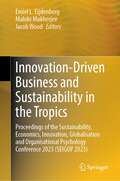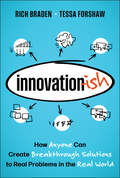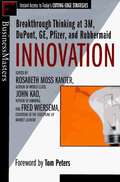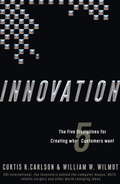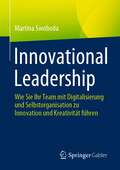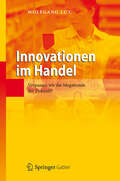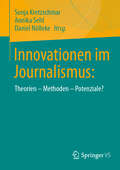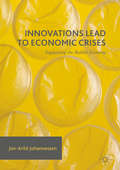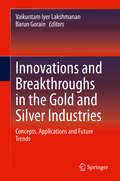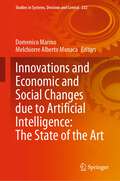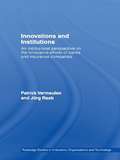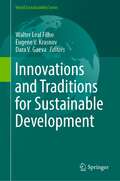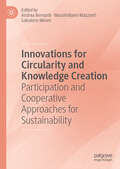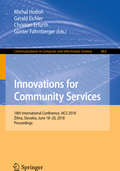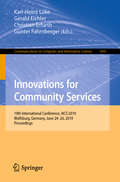- Table View
- List View
Innovation-Driven Business and Sustainability in the Tropics: Proceedings of the Sustainability, Economics, Innovation, Globalisation and Organisational Psychology Conference 2023 (SEIGOP 2023)
by Emiel L. Eijdenberg Malobi Mukherjee Jacob WoodThe edited volume presents the conference proceedings from the “Sustainability, Economics, Innovation, Globalisation and Operational Psychology Conference 2023” (SEIGOP 2023), organized by the Centre for International Trade and Business in Asia (CITBA) at James Cook University, Singapore. This edited volume places the highly dynamic, but also, jeopardized climatological – geographical region of the Tropics centre stage. The region is developing rapidly, with significant progress being made through the development of innovative technologies. The Tropics represent a region in which people live amid the greatest level of biodiversity anywhere on the planet. Nonetheless, propelled by rapid population growth, the Tropics is a region on the rise, with higher living standards and increased levels of international trade and investment. Densely populated emerging countries like India, Indonesia and Nigeria will be among the largest economies of the world by the end of the century. These upward socioeconomic trends are compromised by the impact of climate change on the Tropics’ biodiversity. Such developments have forced policymakers, businesses, and local communities to search for more sustainable and creative ways to live and work. For these reasons, this edited volume presents theory-driven conceptual, qualitative, quantitative and mixed-methods studies on the impact of innovation-driven businesses on the complex interplay of socio-cultural, economic, and environmental factors in the Tropics.
Innovation-ish: How Anyone can Create Breakthrough Solutions to Real Problems in the Real World
by Rich Braden Tessa ForshawIn a World Where Problems are Everywhere, See Opportunity. Your Essential Guide to Everyday Innovation. Innovation-ish: How Anyone Can Create Breakthrough Solutions to Real Problems in the Real World is your no-nonsense guide to unlocking your innate creativity. Expertly crafted by design strategist Richard Braden and cognitive scientist Tessa Forshaw, this book skips the fluff and dives straight into actionable strategies to ignite your innovative potential. Shadow Rich and Tessa through their years of experience. Get behind the scenes access to classrooms, companies, and institutions alongside students and professionals, just like you. Hear stories of real people with real challenges and how they learn and discover innovative new solutions by unlocking their creative potential. Innovation-ish shows you how to solve problems and generate solutions in a huge variety of personal and professional situations. It’s a must-read for people at any stage of life and at any point on their innovation journey. If you're new to innovation, this new way of thinking about innovation gives you an easy way in and helps set you on the path. If you've been trying to innovate and haven't been successful, Innovation-ish explains why you've been struggling and how to turn your project around. If you're experiencing “imposter syndrome,” Innovation-ish reassures you that you're in the right place and have what you need to do it. If you have been successful, Innovation-ish helps you amplify it. They demystify the myths that surround innovation, reveal the six mindsets that underlie innovation, and show how the moves you make drive innovation forward. And they share the latest relevant cognitive science research in a compelling and digestible way - no degree required. After years as design educators at Harvard and Stanford and consulting with clients around the world they have seen that anyone, regardless of their background, can be Innovation-ish. Packed with clear, actionable steps, it's the definitive guide for managers, executives, entrepreneurs, founders, and team leaders ready to turbocharge their organizations, projects, and careers. With an Innovation-ish approach, you can solve problems and generate solutions to challenges in your personal life, a small business, a startup or in any department or function of any type of organization. All you need is an open mind and small sense of adventure. Let's go!
Innovation: A Customer-Driven Approach
by Marco Iansiti Thomas J. Kosnik Ellen SteinProvides a selection of methodologies for the investigation of user needs, concept development, and product design.
Innovation: Breakthrough Thinking at 3M, DuPont, GE, Pfizer, and Rubbermaid
by John Kao Rosabeth Moss Kanter Fred WiersemaHow breakthrough thinking helps the business world
Innovation: The Five Disciplines for Creating What Customers Want
by William W. Wilmot Curtis R. CarlsonNothing is more important to business success than innovation ... And here's what you can do about it on Monday morning with the definitive how-to book from the world's leading authority on innovation. When it comes to innovation, Curt Carlson and Bill Wilmot of SRI International know what they are talking about--literally. SRI has pioneered innovations that day in and day out are part of the fabric of your life, such as: *The computer mouse and the personal computer interface you use at home and work *The high-definition television in your living room *The unusual numbers at the bottom of your checks that enable your bank to maintain your account balance correctly *The speech-recognition system used by your financial services firm when you call for your account balance or to make a transaction. Each of these innovations--and literally hundreds of others--created new value for customers. And that's the central message of this book. Innovation is not about inventing clever gadgets or just "creativity." It is the successful creation and delivery of a new or improved product or service that provides value for your customer and sustained profit for your organization. The first black-and-white television, for example, was just an interesting, cool invention until David Sarnoff created an innovation--a network--that delivered programming to an audience. The genius of this book is that it provides the "how" of innovation. It makes innovation practical by getting two groups who are often disconnected--the managers who make decisions and the people on the front lines who create the innovations--onto the same page. Instead of smart people grousing about the executive suite not recognizing a good idea if they tripped over it and the folks on the top floor wondering whether the people doing the complaining have an understanding of market realities, Carlson and Wilmot's five disciplines of innovation focus attention where it should be: on the creation of valuable new products and services that meet customer needs. Innovation is not just for the "lone genius in the garage" but for you and everyone in your enterprise. Carlson and Wilmot provide a systematic way to make innovation practical, one intimately tied to the way things get done in your business. Teamwork isn't enough; Creativity isn't enough; A new product idea isn't enough; True innovation is about delivering value to customers. Innovation reveals the value-creating processes used by SRI International, the organization behind the computer mouse, robotic surgery, and the domain names .com, .org, and .gov. Curt Carlson and Bill Wilmot show you how to use these practical, tested processes to create great customer value for your organization.
Innovational Leadership: Wie Sie Ihr Team mit Digitalisierung und Selbstorganisation zu Innovation und Kreativität führen
by Martina SwobodaUm ein Unternehmen widerstandsfähig aufzustellen und innovativ zu arbeiten, brauchen Führungskräfte passionierte und motivierte Mitarbeiter. Die Autorin stellt in diesem Buch das nachhaltige Konzept Innovational Leadership vor, welches einen Weg hin zu einer Führungskultur zeigt, die Innovationen und Kreativität fördert und in das Alltagsgeschäft integriert. Innovational Leadership inspiriert Menschen, kreativ zu arbeiten, Innovation zu schaffen und Sinn und Freude an ihrer Arbeit zu erleben. Digitalisierung, hybride Führung und selbstorganisierte Teams bilden dafür das Fundament.Aus der Praxis für die Praxis: Innovational Leadership wurde von der Autorin selbst entwickelt und erfolgreich in einem Konzern eingesetzt. Es erwarten Sie zahlreiche Praxisbeispiele, konkrete Tipps für die Umsetzung und Anregungen für die ersten Schritte. Da Innovation von Inspiration lebt, finden Sie zudem Interviews mit Experten und anderen Praktikern zu Themen wie hybride Führung, agile Organisationen, soziale Innovationen etc.Der InhaltDie Methode Innovational LeadershipDie Zukunft digital gestalten – von Ängsten und MöglichkeitenMit Selbstorganisation das Basisgeschäft sichernVon innovativen ArbeitsweltenDie selbst innovierende Organisation
Innovationen für gemeinsamen Gewinn: Wie Unternehmen nachhaltig Wert für ihre Stakeholder schaffen
by Gerhard SpeckbacherDas Buch bietet eine Einführung in betriebswirtschaftliches Denken und unternehmerisches Handeln. In den vergangenen Jahren haben sich die Innovationsprozesse und Wertschöpfungsstrukturen in Unternehmen fundamental verändert. Dem trägt dieses Buch Rechnung, indem es Innovationen für die gemeinsame Wertschöpfung durch und für die Stakeholder eines Unternehmens als Leitidee ins Zentrum der modernen BWL stellt.Der Prozess der Wertschöpfung durch Innovationen wird aus sieben Perspektiven beleuchtet, beginnend mit der unternehmerischen Perspektive über die finanzwirtschaftliche Perspektive bis hin zur übergreifenden ethischen Perspektive. Die Darstellung der Inhalte folgt einem Problem-based Approach, indem jedes Thema zuerst über Fallbeispiele greifbar gemacht wird. Das Buch richtet sich an Studierende und alle, die sich für einen neuen, innovationsorientierten Zugang zur BWL interessieren. Es soll Begeisterung wecken für die Entwicklung kreativer Ideen für gemeinsame Wertschöpfung in Unternehmen und sozialen Organisationen sowie das für deren professionelle Umsetzung notwendige Grundlagenwissen bereitstellen.
Innovationen im Gesundheitswesen: Rechtliche und ökonomische Rahmenbedingungen und Potentiale
by Philipp Plugmann Roman Grinblat Daniela EttererInitiatoren von Innovationen im Gesundheitswesen müssen eine ganze Reihe von zum Teil vielschichtigen Herausforderungen meistern – hier gilt es, rechtliche, regulative wie ökonomische Rahmenbedingungen im Blick zu behalten und dennoch alle Potentiale zu heben. Dieses Fachbuch gibt aus verschiedenen Perspektiven einen breiten Überblick darüber, wie Recht und Ökonomie das Gesundheitswesen beeinflussen, prägen und verändern. Dabei werden auch interdisziplinäre Einflüsse von Schlüsseltechnologien wie Künstlicher Intelligenz eingebunden sowie Themen des Datenschutzes und Haftungsfragen analysiert und bearbeitet, die gegenwärtig und zukünftig bei Fragestellungen zu Innovationen bei Medizinprodukten, Medikamenten und Apps eine Rolle spielen. Insofern wagt das Buch über den Status quo hinaus eine Prognose in die weitere Entwicklung des deutschen Gesundheitswesens. Dabei behält es stets auch den Praxisbezug im Blick und verweist auf verschiedene Best-Practice-Beispiele.
Innovationen im Handel
by Wolfgang LuxIn dem Buch legt der Autor dar, wie sich der Handel durch neue Entwicklungen wie Nachhaltigkeit, demographischer Wandel, mobiles Internet, soziale Netze u. ä. verändern wird. Ist der Handel in Deutschland dafür gewappnet? Praxisnah und allgemeinverständlich geschrieben, zeigt das erste Buch zum Innovationsstau im deutschen Handel, welche Voraussetzungen zu schaffen sind. Der Band basiert u. a. auf Interviews mit Vorständen und Geschäftsführern der deutschen Handels- und IT-Branche, die ein klares Bild der Branche und ihrer Zukunft zeichnen.
Innovationen im Journalismus: Theorien – Methoden – Potenziale?
by Annika Sehl Sonja Kretzschmar Daniel NöllekeDer Wandel von Journalismus und Medien ist eine Konstante im digitalen Zeitalter. Dieser Wandel betrifft die Mikro- und Meso- ebenso wie die Makroebene. Neue Akteure sind hinzugekommen, tradierte Geschäftsmodelle von Medienunternehmen ins Wanken geraten und die Plattformisierung wirft neue Fragen nach Gemeinwohl auf. Wie können Medienorganisationen die Herausforderungen meistern und einen qualitativ hochwertigen Journalismus sicherstellen? Was kann die Journalismusforschung leisten? Dieser Sammelband verfolgt das Ziel, das breite Spektrum von Innovationen in Journalismus und Medien wissenschaftlich einzuordnen und zu strukturieren. Dabei werden sowohl theoretische Annäherungen, als auch praxisnahe Umsetzungsformen diskutiert. Der Sammelband geht auf eine Tagung der DGPuK-Fachgruppe Journalistik/Journalismusforschug zum selbigen Thema zurück.
Innovationen im Personalmanagement: Die spannendsten Entwicklungen aus der HR-Szene und ihr Nutzen für Unternehmen
by Nele GrafDieses Werk stellt erstmals herausragende und ungewöhnliche Innovationen im Personalmanagement vor. Verantwortliche im Bereich Human Resources müssen immer kreativer werden, um die an sie gestellten Anforderungen zu erfüllen und sich als strategischer Partner zu positionieren. Daher ist es notwendig, über neue Entwicklungen im Recruiting, der Personalentwicklung und dem HR-Management allgemein auf dem Laufenden zu bleiben und Relevantes umzusetzen. Personalverantwortliche, Geschäftsführer, Berater, Studenten und Start-Ups erfahren, was sich im Personalmanagement tut und wie sie die neuen Entwicklungen für sich nutzen können.
Innovationen in der Gesundheitsversorgung: Neue Ansätze und Impulse für Prävention, Gesundheitsförderung und Homecare
by Philipp Plugmann Julia PlugmannWährend Digitalisierung, Innovationen, Forschung und Entwicklung im Bereich Medizintechnik und -produkte und Life Science die Diagnose- und Therapieverfahren verbessern und viele Fortschritte ermöglichen, werden andererseits durch den demografischen Wandel, den zunehmenden Fachkräftemangel, den Druck auf den deutschen Mittelstand und den immer stärker werdenden internationalen Wettbewerb, gesundheitsökonomische Grenzen für die Bezahlbarkeit unserer Gesundheit gesetzt, die Auswirkungen auf Quantität und Qualität der deutschen und europäischen Gesundheitsversorgung haben werden.Deshalb ist es besonders wichtig, rechtzeitig die Innovationspotenziale dieser Branche auszuloten und zu heben. Die Beiträge in diesem Buch zu Themen wie Cybersicherheit, betriebliches Gesundheitsmanagement, personalisierte Prävention, Psychologie, Technologie und Home Care liefern neue Ansätze und Impulse und leiten konkrete Handlungsempfehlungen für etablierte Unternehmen und Start-Ups in der Gesundheitswirtschaft ab.
Innovationen in der Wirtschaft: Trends in Industrie, Bildung und Gesundheit
by Philipp Plugmann Sabrina KraussDer globale Wettbewerb zwingt Unternehmen innovative Produkte und Dienstleistungen in immer kürzeren Innovationszyklen zu liefern. Um diese Performance leisten zu können müssen Zukunftstrends und Szenarien zahlreicher Branchen antizipiert und frühzeitig in Projekte und Zielsetzungen integriert werden, dabei können Experimente auch eine Rolle spielen. In diesem Buch stellen verschiedene Autoren aus Wissenschaft und Praxis unterschiedliche Entwicklungen, Zukunftstrends und Szenarien aus verschiedenen Bereichen der Industrien, dem Hochschuldbildungssektor und dem Gesundheitswesen dar. Leserinnen und Leser aus der Praxis erhalten Denkanstöße und Handlungsempfehlungen für Aktivitäten, im Rahmen der Gestaltung von Innovationskonzepten für die Zukunft, in ihrem Unternehmen oder Arbeitsfeld umsetzen können.
Innovationen und Innovationsmanagement im Gesundheitswesen: Technologien, Produkte und Dienstleistungen voranbringen
by Mario A. Pfannstiel Christoph Rasche Kristin KasselIm aktuellen Gesundheitsmarkt entstehen vielfältige innovative Produkte und Dienstleistungen, die dazu beitragen, die Qualität und Sicherheit der medizinischen Versorgung weiter zu steigern. Voraussetzung für die Entstehung von Innovationen sind Akteure, die Potenziale und Lösungswege aufspüren und den Mut haben kreative Ideen in die Tat umzusetzen sowie ein innovationsfreundliches Klima in Unternehmen. Dazu gehören Handlungsspielräume zum Ausprobieren, Erproben und Experimentieren für Mitarbeiter und auf der Führungsebene eine Akzeptanz für ein gewisses Maß an Fehlschlägen, die bei der Suche nach Lösungen entstehen. Nur so können Innovationen den Ausgangspunkt für den wirtschaftlichen Erfolg von Unternehmen bilden und zur treibenden Kraft in der Gesundheitswirtschaft werden.Dieses Buch stellt Best-Practice-Beispiele vor und zeigt dabei auf, welche Ansätze, Vorgehensweisen und Methoden sich für das Erreichen von unternehmerischen Innovationszielen besonders gut eignen. Zugleich bietet es einen ganzheitlichen Ansatz von Innovationsmanagement für Entscheidungsträger, Praktiker und Wissenschaftler.
Innovations Lead to Economic Crises
by Jon-Arild JohannessenThis book examines the link between innovation and economic crises through a systemic philosophy of economic history. Taking the end of the Roman Empire as its starting point, the author guides readers through six economic crises that have occurred up to the present day and uncovers how these may have been triggered by a number of political, economic and technological innovations. The author presents analyses on the Dutch tulip bubble of 1637, the Mississippi bubble in eighteenth-century France, the development of the first limited liability company and the world's first stock exchange before going on to discuss the latest economic crisis and its links with globalisation and social connectivity following the technological advancement of the internet. The author concludes by explaining how we can use knowledge of the links between innovation and crises to frame a vital new model for policy makers and political leaders. The result is a fascinating insight into the cause of economic crises which will be of particular interest to students and researchers of economic history, financial crises, innovation and political science.
Innovations Lead to Economic Crises: Explaining the Bubble Economy
by Jon-Arild JohannessenThis book examines the link between innovation and economic crises through a systemic philosophy of economic history. Taking the end of the Roman Empire as its starting point, the author guides readers through six economic crises that have occurred up to the present day and uncovers how these may have been triggered by a number of political, economic and technological innovations. The author presents analyses on the Dutch tulip bubble of 1637, the Mississippi bubble in eighteenth-century France, the development of the first limited liability company and the world’s first stock exchange before going on to discuss the latest economic crisis and its links with globalisation and social connectivity following the technological advancement of the internet. The author concludes by explaining how we can use knowledge of the links between innovation and crises to frame a vital new model for policy makers and political leaders. The result is a fascinating insight into the cause of economic crises which will be of particular interest to students and researchers of economic history, financial crises, innovation and political science.
Innovations and Breakthroughs in the Gold and Silver Industries: Concepts, Applications and Future Trends
by Vaikuntam Iyer Lakshmanan Barun GorainThe book describes all aspects of technical innovation related to the gold and silver industries, from ore identification through to processing. It includes details of comminution, pre-concentration and beneficiation, commercially available and recently developed innovative pyro and hydrometallurgical processes, including leaching processes, separation and purification, and recovery and refining. The book focuses on capital and operating cost estimation, process simulation, waste remediation and minimization. Sustainable gold and silver processes are examined with the use of clean technologies and efficient use of energy and water. Topics such as supply and demand of gold and silver, their exchange in major global markets, and the factors that influence gold and silver prices and major economic indices are discussed.Presents emerging trends and innovations in the areas of ore body knowledge, mining, processing, waste management, economics, finance and automation;Describes emerging enablers for the gold and silver industries such as digitization, automation and remote operations;Promotes breakthroughs in mining, processing, waste management, energy and water from an integrated operations perspective.
Innovations and Economic and Social Changes due to Artificial Intelligence: The State of the Art (Studies in Systems, Decision and Control #222)
by Domenico Marino Melchiorre Alberto MonacaThe book aims to deal with the main advances in the study of artificial intelligence, the digital and circular economy, and innovation from a multidisciplinary perspective. Whoever governs the artificial intelligence will hold the keys to the world and the future. This book explains the growing role of artificial intelligence in our lives and the need to understand its mechanisms. The book presents original research articles addressing various aspects of artificial intelligence applied to economics, law, management, and optimization. The topics discussed include economics, territorial policies, law, resource allocation strategies, information technology, and learning for inclusion. Combining the input of contributing professors and researchers from Italian and other foreign universities, the book is of interest to students, researchers, and practitioners, as well as members of the public in general, interested in the world of the artificial intelligence and economics.
Innovations and Institutions: An Institutional Perspective on the Innovative Efforts of Banks and Insurance Companies (Routledge Studies In Innovation, Organizations And Technology Ser. #4)
by Patrick Vermeulen Jorg RaabUsing institutional theory to explain innovation and merging academic and critical analysis with practical recommendations, this book provides a full and rich account of how new products are brought to market; considering both the successes and failures in equal measure.This book takes the meeting point of two seemingly incongruous schools of theor
Innovations and Social Media Analytics in a Digital Society
by Maria José Sousa and Célio Gonçalo MarquesRecent advances in digitization are transforming healthcare, education, tourism, information technology, and some other sectors. Social media analytics are tools that can be used to measure innovation and the relation of the companies with the citizens. This book comprises state-ofthe-art social media analytics, and advanced innovation policies in the digitization of society. The number of applications that can be used to create and analyze social media analytics generates large amounts of data called big data, including measures of the use of the technologies to develop or to use new services to improve the quality of life of the citizens. Digitization has applications in fields from remote monitoring to smart sensors and other devices. Integration generates data that need to be analyzed and visualized in an easy and clear way, that will be some of the proposals of the researchers present in this book. This volume offers valuable insights to researchers on how to design innovative digital analytics systems and how to improve information delivery remotely.
Innovations and Technologies in Construction: Selected Papers of BUILDINTECH BIT 2021 (Lecture Notes in Civil Engineering #151)
by Sergey Vasil’yevich Klyuev Nikolay Ivanovich Vatin Alexander Vasil’yevich KlyuevThis book gathers the latest advances, innovations, and applications in the field of building design and construction, as presented by researchers and engineers at the International Conference BUILDINTECH BIT 2021, Innovations and Technologies in Construction, held in Belgorod, Russia, on March 9-10, 2021. It covers highly diverse topics, including building materials, industrial and civil construction, structural mechanics and theory of structures, computational methods and IT in construction, organization and technologies of construction production. The contributions, which were selected by means of a rigorous international peer-review process, highlight numerous exciting ideas that will spur novel research directions and foster multidisciplinary collaborations.
Innovations and Traditions for Sustainable Development (World Sustainability Series)
by Walter Leal Filho Eugene V. Krasnov Dara V. GaevaThis book highlights the vital necessity for combining sustainable development processes from different areas, with applications in areas such as science, education and production sectors. These sectors have previously been separated by linguistic and technological barriers. Breaking down these barriers will allow an interdisciplinary and transdisciplinary flow of information, leading to greater efficiency, and towards a more real resilient and sustainable economy development. This book fills in the gap in respect of publications addressing aspects of innovation and sustainable development and focuses on a range of areas, such as I. Gradual transition to innovative development; II. Continuity of technology in education, science and industry; III. Convergency directions, interdisciplinary relations in scientific research; IV. Digital technologies for sustainable development; V. Global trends and regional aspects of innovation and traditions in environmental management; VI. International legal regulations and environmental and economic relations among business communities. The publication fosters the global efforts towards taking better advantage of the many opportunities which innovation in specific areas may offer.
Innovations for Circularity and Knowledge Creation: Participation and Cooperative Approaches for Sustainability
by Massimiliano Mazzanti Andrea Bernardi Salvatore MonniCo-operatives are increasingly being recognized as important contributors to inclusive, sustainable and fair development. However, the co-operative movement faces a multitude of challenges, including the lack of access to credit. This book presents existing cases and new examples of the intersection between the co-operative economy and sustainability challenges. Chapters explore innovative circular and low carbon sustainable economy cases and practical examples of the role of co-operative organizations within the European Union. It asks how policy factors influence sustainability innovations, explores the role of workers’ involvement in firm strategies and analyses the management style of cooperative firms in facing sustainability challenges. This book will be an essential resource for scholars and students of sustainability and the circular economy, innovation management, HRM and labour studies.
Innovations for Community Services: 18th International Conference, I4CS 2018, Žilina, Slovakia, June 18-20, 2018, Proceedings (Communications in Computer and Information Science #863)
by Günter Fahrnberger Gerald Eichler Christian Erfurth Michal HodoňThis book constitutes the refereed proceedings of the 18th International Conference on Innovations for Community Services, I4CS 2018, held in Žilina, Slovakia, in June 2018.The 14 revised full papers and the three revised short papers presented in this volume were carefully reviewed and selected from 38 submissions. The papers are organized in topical sections on architectures and management; data analytics and models; community and public collaboration; innovations and digital transformation.
Innovations for Community Services: 19th International Conference, I4CS 2019, Wolfsburg, Germany, June 24-26, 2019, Proceedings (Communications in Computer and Information Science #1041)
by Günter Fahrnberger Gerald Eichler Christian Erfurth Karl-Heinz LükeThis book constitutes the refereed proceedings of the 19th International Conference on Innovations for Community Services, I4CS 2019, held in Wolfsburg, Germany, in June 2019. The 16 revised full papers presented in this volume were carefully reviewed and selected from 43 submissions. The papers are organized in topical sections on communication systems; teaching and collaboration; smart cities; innovations and digital transformation; data analytics and models; community and quality.
